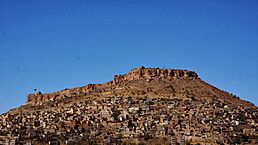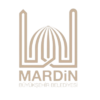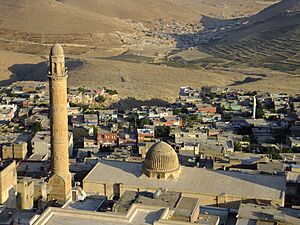Mardin facts for kids
Mardin (Kurdish: Mêrdîn; Arabic: ماردين; Syriac: ܡܪܕܝܢ, romanized: Merdīn; Armenian: Մարդին) is a beautiful city in Turkey. It is the main city of the Mardin Province. Mardin is famous for its amazing old buildings, especially those built by the Artuqids. It sits on a rocky hill close to the Tigris River, which made it an important place long ago.
The old part of Mardin is so special that UNESCO protects it. This means no new buildings can be built there, helping to keep its ancient look. In 2021, about 129,864 people lived in Mardin. The people living here come from different backgrounds, including Kurds, Arabs, and Syriac Christians.
Contents
History of Mardin
Ancient Times
Mardin has a very long history. In ancient times, around 150 BC to 250 AD, it was part of a kingdom called Osroene. The city was known as Marida or Merida by the Romans. This name came from a Syriac word that means "fortress," which makes sense because of its strong location on a hill.
Medieval Period
During the early Muslim conquests, the city was captured by Muslim armies in 640 AD. For many centuries, different groups fought for control of Mardin. The city often changed hands between various dynasties.
In 1085, the Great Seljuks arrived, which brought Turkish rule to the area. From 1103, Mardin became the capital for one part of the Artuqid dynasty. This was a Turkish family who built many of Mardin's famous historical buildings. These include mosques and schools called madrasas.
The Mongol invasion reached Mardin between 1235 and 1243. The Artuqid rulers decided to work with the Mongols and continued to govern the city under their rule. Later, in 1394, Timur invaded the region. Mardin then became a place that different powers fought over.
In 1507, the Safavid ruler Ismail I captured the city and its castle. During the medieval period, many Assyrians and Armenians lived in Mardin. It was an important center for different Christian churches. A visitor in 1507 even wrote that there were more Christians and Jews in the city than Muslims.
Ottoman Rule
After the Ottomans won a big battle against the Safavids in 1514, they took control of Mardin. The city finally surrendered to the Ottomans in late 1516 or early 1517. After this, Mardin was directly governed by the Ottoman Sultan.
Life in Mardin was quite peaceful under Ottoman rule for a long time. European travelers in the 1700s and 1800s noted that Muslims were the largest group, but there were also many Armenian and Assyrian communities. Arabic and Kurdish were the main languages spoken.
This peaceful time ended when the Ottoman Empire faced problems. In 1835, a Kurdish tribe in Mardin was defeated by Ottoman troops. During this time, the city's Great Mosque was damaged. Between 1847 and 1865, a serious cholera sickness affected the city.
During World War I, Mardin faced very difficult times. Many Assyrian and Armenian people living there were forced to leave their homes or faced great danger. Some managed to escape to the Sinjar Mountains. Local Kurds and Arabs often call these events "fırman" (government order), while Syriacs call it "seyfo" (sword). After the war, Mardin was one of the few Turkish cities not taken over by Allied forces.
Modern Times
In 1923, when the Republic of Turkey was founded, Mardin became the capital of its own province. Many Assyrians who survived the difficult times later moved to nearby Qamishli in the 1940s. This happened after they were required to join the Turkish Army.
Mardin grew a lot in the 1990s. More people moved to the newer parts of the city, which were built on lower ground. In 2012, Mardin became a metropolitan municipality, which is a larger type of city government. Today, the city has many Arab and Kurdish people.
Geography of Mardin
Mardin is located close to the Syrian border. The old part of the city is built on the southern side of a long hill. This hill slopes down towards the flat Mesopotamian plain. At the very top of the hill is the city's old citadel.
The newer parts of Mardin are located on lower ground. They are to the northwest and in the areas around the old city. These new areas have modern buildings and facilities. Mardin Airport is about 20 kilometers (12 miles) southwest of the old town.
City Neighborhoods
Mardin is divided into several neighborhoods. Some of these include 13. Mart, Cumhuriyet, Çabuk, Diyarbakırkapı, Eminettin, Ensar, Gül, Hamzabey, İstasyon, Kayacan, Kotek, Latifiye, Medrese, Necmettin, Nur, Ofis, Saraçoğlu, Savurkapı, Şar, Şehidiye, Teker, Yalım (Mansuriye), Ulucami, Yenıkapı and Yenişehir.
Climate and Weather
Mardin has a hot-summer Mediterranean climate. This means it has very hot and dry summers. Winters are chilly, wet, and sometimes it snows. Mardin is a very sunny city, with over 3000 hours of sunshine each year.
Summer temperatures can easily reach 40°C (104°F). Even though it's hot in summer, winter weather is common from December to March. It usually snows for one or two weeks. The highest temperature ever recorded in Mardin was 42.5°C (108.5°F).
| Climate data for Mardin (1991–2020 normals, extremes 1941–2023) | |||||||||||||
|---|---|---|---|---|---|---|---|---|---|---|---|---|---|
| Month | Jan | Feb | Mar | Apr | May | Jun | Jul | Aug | Sep | Oct | Nov | Dec | Year |
| Record high °C (°F) | 19.4 (66.9) |
19.5 (67.1) |
27.5 (81.5) |
33.6 (92.5) |
35.4 (95.7) |
40.0 (104.0) |
42.5 (108.5) |
42.0 (107.6) |
40.5 (104.9) |
35.6 (96.1) |
26.1 (79.0) |
24.1 (75.4) |
42.5 (108.5) |
| Mean daily maximum °C (°F) | 6.7 (44.1) |
8.2 (46.8) |
12.8 (55.0) |
18.2 (64.8) |
24.6 (76.3) |
31.6 (88.9) |
35.9 (96.6) |
35.5 (95.9) |
30.7 (87.3) |
23.9 (75.0) |
14.9 (58.8) |
8.8 (47.8) |
21.0 (69.8) |
| Daily mean °C (°F) | 3.7 (38.7) |
4.7 (40.5) |
8.8 (47.8) |
14.0 (57.2) |
19.9 (67.8) |
26.1 (79.0) |
30.3 (86.5) |
30.2 (86.4) |
25.6 (78.1) |
19.3 (66.7) |
11.2 (52.2) |
5.8 (42.4) |
16.6 (61.9) |
| Mean daily minimum °C (°F) | 1.3 (34.3) |
1.8 (35.2) |
5.5 (41.9) |
10.2 (50.4) |
15.4 (59.7) |
20.9 (69.6) |
25.2 (77.4) |
25.5 (77.9) |
21.3 (70.3) |
15.5 (59.9) |
8.1 (46.6) |
3.4 (38.1) |
12.8 (55.0) |
| Record low °C (°F) | −13.4 (7.9) |
−14.0 (6.8) |
−11.7 (10.9) |
−5.3 (22.5) |
2.6 (36.7) |
0.6 (33.1) |
11.8 (53.2) |
12.8 (55.0) |
8.0 (46.4) |
−2.5 (27.5) |
−9.5 (14.9) |
−11.9 (10.6) |
−14.0 (6.8) |
| Average precipitation mm (inches) | 95.4 (3.76) |
92.2 (3.63) |
83.5 (3.29) |
66.8 (2.63) |
51.7 (2.04) |
8.8 (0.35) |
4.8 (0.19) |
4.2 (0.17) |
5.4 (0.21) |
31.7 (1.25) |
64.6 (2.54) |
101.0 (3.98) |
610.1 (24.02) |
| Average precipitation days (≥ 1 mm) | 9.5 | 9.1 | 9.0 | 7.8 | 6.0 | 2.0 | 1.4 | 1.4 | 1.4 | 4.5 | 6.0 | 8.9 | 67.0 |
| Average relative humidity (%) | 64.7 | 62.1 | 57.0 | 51.9 | 41.3 | 30.5 | 25.9 | 26.9 | 31.7 | 42.6 | 52.9 | 62.7 | 45.8 |
| Mean monthly sunshine hours | 142.6 | 144.1 | 189.1 | 231.0 | 306.9 | 369.0 | 390.6 | 356.5 | 312.0 | 238.7 | 180.0 | 136.4 | 2,996.9 |
| Source 1: Turkish State Meteorological Service | |||||||||||||
| Source 2: NOAA (precipitation days and humidity) | |||||||||||||
People of Mardin
In the early 1900s, a traveler named Mark Sykes wrote that Mardin was home to Arabs, Armenians, and Jacobites (a group of Syriac Christians). Most of the Christians spoke Arabic. Sadly, during difficult times in the late Ottoman period, many Christians faced great danger.
Today, most people in Mardin are Kurdish and Arab. There are also important communities of Syriac Christians. While official numbers for different groups are not kept, a study in 2013 suggested that about 49% of the people identified as Arab and 49% as Kurdish.
The city has three main parts:
- Old Mardin (Eski Mardin): This part is mostly home to Arabs, along with some Kurdish and Syriac families.
- The Slums (Gecekondu): This area is mainly where Kurds live who moved after conflicts in the 1980s and 1990s.
- The New City (Yenişehir): This is where wealthier people live. Most government workers, who are usually Turks, also live here.
Economy of Mardin
Historically, Mardin was known for growing sesame. Even today, Mardin province produces many farm products. These include sesame, barley, wheat, corn, and cotton. Farmers in the area also raise Angora goats. There is a small industry that makes things from cotton and wool. Many farms are run by families.
Mardin was also an important trading center. It was on the trade routes between Anatolia, Mesopotamia, and northern Syria. Today, trade with Syria and Iraq can change depending on political situations.
Historical Landmarks
Mardin is often called an "open-air museum" because of its many old buildings. Most buildings are made from a special beige-colored limestone. This stone has been dug up from quarries around the city for hundreds of years.
Mosques and Madrasas
- Great Mosque (Ulu Cami) of Mardin: This is the main historic mosque of the city. It was likely first built in the 1170s by the Artuqids. It was damaged in the early 1800s and then rebuilt. The beautiful wooden minbar (pulpit) from the original mosque is still there.
- Sultan İsa (or Zinciriye) Medrese: This is one of the most impressive Islamic buildings in Mardin. It was built in 1385 during the time of Artuqid sultan Al-Zahir Majd al-Din 'Isa. It was a school (madrasa) and also has a mosque and a tomb. It has a grand entrance and two ribbed domes that stand out on the city's skyline.
- Kasım Pasha (or Kasımiye) Medrese: Another important Islamic building started by Sultan 'Isa. It was finished in 1445. It has a large central courtyard and a grand entrance.
- Emineddin Külliyesi: This is a group of religious and charity buildings. It is thought to be the oldest Islamic monument in Mardin. It includes a mosque, a former madrasa, a fountain, and a bathhouse (hammam).
- Hatuniye Medrese or Sitt Ridwiyya Madrasa: This building is believed to have been built by the Artuqid sultan Qutb ad-Din Il-Ghazi II. It now serves as a mosque.
Churches
- Meryem Ana (Virgin Mary) Church: This is a Syriac Catholic Church. It was built in 1895.
- Mor Behnam or Kırklar (Forty Martyrs) Church: This is a Syriac Orthodox Church. It was built in the mid-6th century. It has a special place with the remains of Mar Behnam.
- Deyrü'z-Zafaran Monastery: Also known as the Saffron Monastery, it is about 5 kilometers (3 miles) southeast of Mardin. This Syriac Orthodox monastery was founded in 493 AD. It is one of the oldest monasteries in the world. From 1160 to 1932, it was the main seat for the Syriac Orthodox Patriarch. People believe the site was used as a temple by sun worshipers as far back as 2000 BC.
Other Important Places
- Citadel: The citadel is an old fortress on the highest point of the city's ridge. It was probably first built in the 900s. Today, it is used as a military radar station.
- Mardin Museum: This is an archaeology museum that tells the story of Mardin's history. It opened in 2000 and is located in a beautiful old building that used to be the Syriac Catholic Patriarchate.
Traditional House Architecture
Houses in Mardin are built on the sloping hills. They often have many levels and terraces. This gives the old city its unique "stepped" look when you see it from far away. Most houses are built around an inner courtyard. Larger houses and public buildings often have beautiful stone carvings around their windows.
City Government
In the 2014 local elections, Ahmet Türk was elected mayor of Mardin. However, he was later removed from his position. In the Municipal elections in March 2019, Türk was re-elected. But he was again removed from his post in August 2019. The Governor of Mardin Province, Mustafa Yaman, was then appointed as the acting mayor.
Famous People from Mardin
- Nabia Abbott (1897–1981), a scholar who studied early Islam.
- Februniye Akyol, a Syriac Co-Mayor of Mardin.
- Malak Karsh, a photographer.
- Feyyaz Duman, a Turkish actor.
- Yousuf Karsh, a famous photographer.
- Sultan Kösen, who has been the world's tallest living man since 2009.
- Murathan Mungan, a poet and writer.
- Mem Ararat, a Kurdish singer.
International Connections
Mardin has a "twin city" relationship with another city around the world. This helps them share culture and ideas.
Twin Cities
Sports in Mardin
Mardin has a few sports teams:
- Mardinspor
- Mardin 1969 Spor
See also
- Shamsīyah
- Armenians in Turkey
- Assyrians in Turkey
- Kurds in Turkey
- Yazidis in Turkey

















